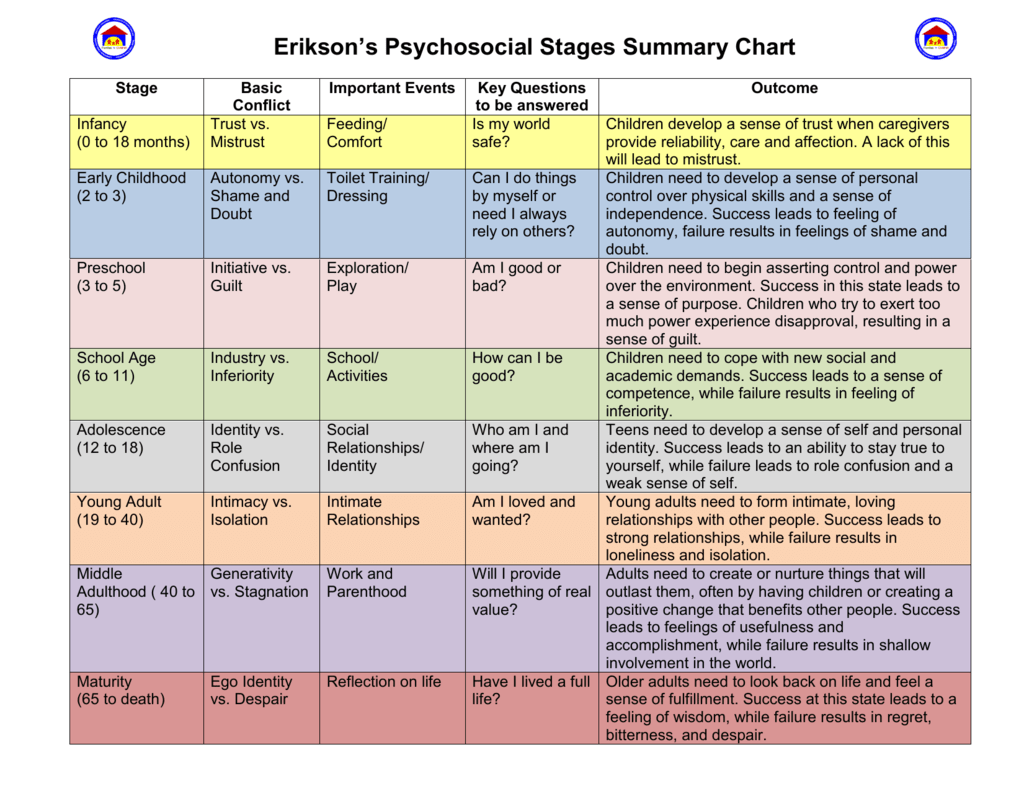It built upon freud’s theory of psychosexual development by drawing parallels in childhood stages while expanding it to include the influence of social dynamics as well as the extension of psychosocial development into adulthood. The first stage of erikson's theory of psychosocial development.

Pin by Mozelle Volkman on Developmental Psychology Stages of
Erik erikson’s psychosocial development theory proposed that throughout our lives, we encounter certain crises that contribute to our psychosocial development.

Erik erikson's stages of psychosocial development. He presented these crises as 8 stages of psychosocial conflicts, often known as the 8 erikson stages. Erikson was a student of anna freud, studying to become a psychoanalyst. The theory proposes that human beings go through eight stages of psychosocial development.
8 rows the fifth stage of erik erikson's theory of psychosocial development is identity vs. Several clinical tools and further research have emanated from and have undergone significant influence by erikson’s stages of development: If they are successful in passing this stage, they will acquire a significant social role that will give back to society.
He presented the ego “in development” as personal identity, shaped and molded by an individual’s experiences. Each stage of erikson’s theory is marked by a certain conflict that the individual must resolve. Each stage is crucial to our development as a whole and at each stage we encounter different needs, ask new questions and meet people who influence our behavior and learning.
Erikson's stages of psychosocial development, as articulated in the second half of the 20th century by erik erikson in collaboration with joan erikson, is a comprehensive psychoanalytic theory that identifies a series of eight stages that a healthy developing individual should pass through from infancy to late adulthood. Died on may 12, 1994 at age 91.psychosocial relating to the interrelation of social factors and. Each of these epigenetic developmental periods.
Adulthood consists of three basic conflict stages: Erik erikson's psychosocial development model has been a leading theory on the stages of human development since 1963. Erikson’s theory of psychosocial development identifies 8 stages in which a healthy individual should pass through from birth to death.
Legg, phd, psyd — written by rhona lewis on april 28, 2020 1. 8 rows stage 1: Erikson’s theory of psychosocial development has eight distinct stage, each with two possible outcomes.
Autonomy versus shame and doubt; His initial four stages of ego growth parallel the classical psychoanalytic psychosexual stages of childhood and then extend beyond them, going from adolescence through to old age. Erik erikson's psychosocial development erik erikson was an ego psychologist who developed one of the most popular and influential theories of development.while his theory was impacted by psychoanalyst sigmund freud's work.
In the late 1950s, erik erikson proposed a psychoanalytic theory of psychosocial development comprising eight stages from infancy to adulthood that was. In other words, as you relate to other people, you go through a series of eight stages in which the goal is to develop a coherent sense of self,. Intimacy versus isolation is the sixth stage of erik erikson's theory of psychosocial development.
While his theory was impacted by psychoanalyst sigmund freud’s work, erikson’s theory centered on psychosocial development rather than psychosexual development. According to the theory, successful. Psychologist erikson viewed personality as a product of social interactions and the choices a person makes in life.
Erikson’s 8 stages of psychosocial development, explained for parents medically reviewed by timothy j. This stage takes place during young adulthood between the ages of approximately 18 to 40 yrs. The stages that make up his theory are as follows:
The erikson psychosocial stage inventory. Instead of focusing on cognitive development, however, he was interested in how children socialize and how this affects their sense of self. Studying erikson’s stages serve as a basis of treatment for different recovery stages of mental illness.[8] for.
Each of the eight erikson stages is characterized by two contradictory emotional forces known as contrary. The theory proposed by erik erikson that ego identity is gradually achieved by facing goals and challenges during eight stages of development across the lifespan. Development of one's identity is not concluded at the end of adolescence.
Erikson's theory centered on psychosocial development rather than psychosexual development. Erikson’s eight stages of psychosocial development. Erik erikson’s theory of psychosocial development encompasses eight stages covering the entire life cycle.
Erikson’s psychosocial development theory the 8 stages of life erik homberger erikson born on june 15, 1902 as erik salomsen in frankurt, germany best known for his famous theory of psychosocial development and the concept of the identity crisis. Erikson’s stages of psychosocial development is a theory introduced in the 1950s by the psychologist and psychoanalyst erik erikson. Role confusion is the fifth stage in erik erikson's theory of psychosocial development, and it occurs throughout adolescence, between the ages of 12 and 18.
During this period, the major conflict centers on forming intimate, loving relationships with 6/11 Each with its own unique challenges. The stages are (a) infancy:
The theory was first proposed by erik erikson in 1950 and has been revised over the years.

Eric Erickson's Psychosocial Development Chart The most widely

Erikson's Stages Of Psychosocial Development Stage Of Human Development

The 8 Erikson Stages of Psychosocial Development

😍 Erikson and psychosocial development. Initiative Vs. Guilt A Stage

Erikson’s Stages of Psychosocial Development Stages of psychosocial
-
An online marketing plan that includes mobile publicity. Pr firms use some business directories, online platforms, social media, publication...
-
Crossing fingers might be one of the most complex gestures invented by humanity. Thumbs up means ok in america but in iran it has the same e...
-
If i improve sales by 15% i can get a promotion. This will help to focus on the strengths, minimize weaknesses and take the greatest possibl...
watch your six
Watch Your Six Meaning, Origin & Example. . When used in combat scenarios, “watch your six” literally means “keep an eye on what’s...

ads
